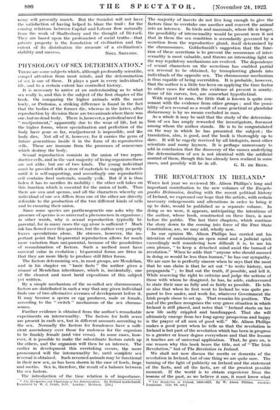PHYSIOLOGY OF SEX DETERMINATION.* THERE are some subjects which, although
profoundly scientific, compel attention from most minds, and the determination of sex is one of these. It plays a part in every individual's life, and to a certain extent has controlled history.
It is necessary to arrive at an understanding as to what sex really is, and this is the subject of the first chapter of the book. On comparing the higher animals with the most lowly, or Protozoa, a striking difference is found in the fact that the bodies of the former die, whereas in the latter, after reproduction by division there are two animals where there was one, but no dead body. There is, however, a periodical need for " readjustment," apparently due to the wear of life, but in the higher forms, where specialization and perfection of the body have gone so far, readjustment is impossible, and the body dies. Not all of it, however, for it carries the germ of future generations inside it in the form of its reproductive cells. These are immune from the processes of senescence which destroy the body.
Sexual reproduction consists in the union of two repro- ductive cells, and in the vast majority of living organisms these are not alike, but are of two kinds. The young individual must be provided with a store of materials to supply its needs until it is self-supporting, and accordingly one reproductive cell contains food materials, usually yolk. But if it is thus laden it has to sacrifice its mobility : the other cell takes on this function which is essential for the union of both. Thus there are ova and sperms, and all the characters whereby an individual of one sex differs from one of the other are directly referable to the production of the two different kinds of cells and to ensuring their union.
Since some species are parthenogenetic one asks why the presence of sperms is so universal a phenomenon in organisms ; in other words, why is sexual reproduction typically bi- parental, for in many cases the egg alone is sufficient ? Much ink has flowed over this question, but the author very properly leaves speculations alone. He stresses, however, the im- portant point that bi-parental reproduction allows for much more variation than uni-parental, because of the possibilities of recombination of- factors. Such a method must have survival value in evolution ; bi-parental forms are fitter in that they are more likely to produce still fitter forms.
The factors determining sex, in most groups, are Mendelian, and in his chapter on " basic facts " the author gives a resume of Mendelian inheritance, which is, incidentally, one of the clearest and most lucid expositions of this subject yet written.
By a simple mechanism of the so-called sex chromosomes, factors are distributed in such a way that any given individual !Inds one of two alternative avenues of development before it. It may become a sperm or egg producer, male or female, according to- the " switch " mechanism of the sex chromo- somes.
Further evidence is obtained from the author's remarkable experiments on intersexuality. The factors for both sexes are present in each sex, but in different amounts according to the sex. Normally the factors for femaleness have a suffi- cient ascendancy over those for maleness for the organism to be frankly female (and vice versa). In some cases, how- ever, it is possible to make the subordinate factors catch up the others, and the organism will then be an intersex. The earlier in development this overtaking occurs, the more pronounced will the intersexuality be, until complete sex reversal is obtained. Such reversed animals may be functional in their new sex, as has been shown in the case of fowls, frogs and moths. Sex is, therefore, the result of a balance between the sex factors.
The introduction of the time relation is of importance.
• The Meeltaniam and l'hytiolow of Sex Determination. By Richard Goldschmldt. Translated by W. J. Balch*, D.Sc. London: Methuen. [218.]
The majority of insects do' not live long enough to give the factors time to overtake one another and convert the animal into an intersex. In birds and mammals, where life is longer, the possibility of intersexuality would be present were it not that in them the sex conditien is secondarily governed by a secretion from the reproductive gland, itself determined by the chromosomes. Goldschmidt's suggestion that the func- tion of these secretions is to prevent the occurrence of inter- sexuality is most valuable, and throws an interesting light on the way regulatory mechanisms are evolved. The dependence of sexual characters on the secretions has enabled partial sex reversal to be obtained, by transplanting glands into individuals of the opposite sex. The chromosome mechanism is thus capable of being overridden. It is probable, however, that the author is a little too keen on applying the time factor to other cases for which the evidence at present is scanty. Some of his curves, too, are somewhat hypothetical.
With regard to man, the little thait is known is quite con- sonant with the evidence from other groups ; and the possi- bility of sex reversal as a result of some genetical or glandular disharmony is by no means excluded in man.
As a whole it may be said that the study of the determina- tion of sex has amply rewarded the investigators, foremost among whom the author stands. He is to be congratulated on the way in which he has presented the subject ; the translation, also, is good, and the book is thoroughly up to date. It will be eagerly received by all biologists, most other scientists and many laymen. It is perhaps unnecessary to add in conclusion that the discovery of the causes underlying the determination of sex is not identical with the artificial control of them, though this has already been realized in some


















































 Previous page
Previous page